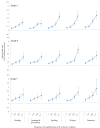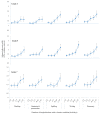School academic performance of children hospitalised with a chronic condition
- PMID: 34475105
- PMCID: PMC8862027
- DOI: 10.1136/archdischild-2020-321285
School academic performance of children hospitalised with a chronic condition
Abstract
Objective: To examine academic outcomes among children hospitalised with a chronic health condition.
Design: Population-level birth cohort.
Setting: New South Wales, Australia.
Participants: 397 169 children born 2000-2006 followed up to 2014.
Intervention/exposure: Hospitalisations with a chronic condition.
Main outcome measures: Academic underperformance was identified as 'below the national minimum standard' (BNMS) in five literacy/numeracy domains using the national assessment (National Assessment Program-Literacy and Numeracy) data. Multivariable logistic regression assessed the adjusted ORs (aORs) of children performing BNMS in each domain at each grade (grades 3, 5 and 7, respectively).
Results: Of children hospitalised with a chronic condition prior to National Assessment Program-Literacy and Numeracy (NAPLAN) (16%-18%), 9%-12% missed ≥1 test, with a maximum of 37% of those hospitalised ≥7 times, compared with 4%-5% of children not hospitalised. Excluding children who missed a NAPLAN test, more children hospitalised with a chronic condition performed BNMS across all domains and grades, compared with children not hospitalised (eg, for BNMS in reading at grade 3: n=2588, aOR 1.35 (95% CI 1.28 to 1.42); for BNMS in numeracy at grade 3: n=2619, aOR 1.51 (95% CI 1.43 to 1.59)). Increasing frequency and bed-days of hospitalisation were associated with 2-3 fold increased odds of performing BNMS across all domains and grades. Children hospitalised with mental health/behavioural conditions had the highest odds of performing BNMS across all domains at each grade.
Conclusions: Children hospitalised with a chronic condition underperform academically across literacy/numeracy domains at each school grade. Health and educational supports are needed to improve these children's academic outcomes.
Keywords: epidemiology; health services research.
© Author(s) (or their employer(s)) 2022. Re-use permitted under CC BY-NC. No commercial re-use. See rights and permissions. Published by BMJ.
Conflict of interest statement
Competing interests: None declared.
Figures



Similar articles
-
Influence of early childhood burns on school performance: an Australian population study.Arch Dis Child. 2018 May;103(5):444-451. doi: 10.1136/archdischild-2017-313355. Epub 2017 Nov 29. Arch Dis Child. 2018. PMID: 29187346
-
Elective labor induction vs expectant management of pregnant women at term and children's educational outcomes at 8 years of age.Ultrasound Obstet Gynecol. 2021 Jul;58(1):99-104. doi: 10.1002/uog.23141. Ultrasound Obstet Gynecol. 2021. PMID: 33030765
-
Perinatal and Child Factors Mediate the Association between Preeclampsia and Offspring School Performance.J Pediatr. 2021 Nov;238:153-160.e4. doi: 10.1016/j.jpeds.2021.06.069. Epub 2021 Jul 1. J Pediatr. 2021. PMID: 34216627
-
School performance in children with prenatal drug exposure and out-of-home care in NSW, Australia: a retrospective population-based cohort study.Lancet Child Adolesc Health. 2024 Jul;8(7):500-509. doi: 10.1016/S2352-4642(24)00076-2. Lancet Child Adolesc Health. 2024. PMID: 38897715
-
History of the BNMS 1966–2016.2016 Mar 10. In: McCready R, Gnanasegaran G, Bomanji JB, editors. A History of Radionuclide Studies in the UK: 50th Anniversary of the British Nuclear Medicine Society [Internet]. Cham (CH): Springer; 2016. Chapter 1. 2016 Mar 10. In: McCready R, Gnanasegaran G, Bomanji JB, editors. A History of Radionuclide Studies in the UK: 50th Anniversary of the British Nuclear Medicine Society [Internet]. Cham (CH): Springer; 2016. Chapter 1. PMID: 29787091 Free Books & Documents. Review.
Cited by
-
Impact of Coinsurance Reduction Policy on Healthcare Utilization Among Children Under 15.J Korean Med Sci. 2023 Oct 9;38(39):e309. doi: 10.3346/jkms.2023.38.e309. J Korean Med Sci. 2023. PMID: 37821086 Free PMC article.
-
Bringing Virtual Reality to Mainstream Pediatric Care.J Patient Cent Res Rev. 2024 Jul 16;11(2):107-111. doi: 10.17294/2330-0698.2063. eCollection 2024 Summer. J Patient Cent Res Rev. 2024. PMID: 39044851 Free PMC article.
-
Psychological Well-Being and Life Satisfaction in Children and Adolescents with Chronic Illness: The Role of Depression, Nonproductive Thoughts, and Problematic Internet Use.Children (Basel). 2025 May 21;12(5):657. doi: 10.3390/children12050657. Children (Basel). 2025. PMID: 40426836 Free PMC article.
-
Gestational age at birth, chronic conditions and school outcomes: a population-based data linkage study of children born in England.Int J Epidemiol. 2023 Feb 8;52(1):132-143. doi: 10.1093/ije/dyac105. Int J Epidemiol. 2023. PMID: 35587337 Free PMC article.
-
Priority setting for children and young people with chronic conditions and disabilities.Health Expect. 2023 Aug;26(4):1562-1574. doi: 10.1111/hex.13761. Epub 2023 Apr 20. Health Expect. 2023. PMID: 37078632 Free PMC article.
References
-
- Agency for Healthcare Research and Quality . Chronic condition indicator (CCI) for ICD-9-CM. Rockville, MD; healthcare cost and utilization project: Rockville, MD; healthcare cost and utilization project, 2011. Available: https://www.hcup-us.ahrq.gov/toolssoftware/chronic/chronic.jsp [Accessed 13 Mar 2019].
-
- WHO . Disease burden and mortality estimates: disease burden. WHO.
-
- Feudtner C, Christakis DA, Connell FA. Pediatric deaths attributable to complex chronic conditions: a population-based study of Washington state, 1980-1997. Pediatrics 2000;106:205–9. - PubMed
Publication types
MeSH terms
LinkOut - more resources
Full Text Sources
Medical
